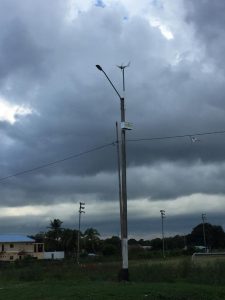THE Guyana Energy Agency (GEA), in a pilot project, has created a stand-alone wind-powered street light as it explores various avenues of increasing the country’s use of renewable sources of energy. If executed on a large scale, the project is likely to reduce the steep cost associated with street lighting.
In a statement on Tuesday, the Ministry of Public Infrastructure (MoPI) disclosed that the prototype was designed by GEA engineers, and that with the assistance of the Traffic and Highway Light Unit, they installed it on the Georgetown Sea Wall, east of Camp Street behind the Ministry of Education Sports Ground.

The light, the ministry says, utilises a wind turbine and generator to harness energy from the wind and convert it into electricity. “The stand-alone wind-powered street light consists of a 500W wind turbine; a 40W LED lamp; a 105Ah battery; hybrid charge controller; timer; enclosure and mounts. The first unit installed by the GEA cost G$247,553. The estimated simple payback for the stand-alone wind-powered street light is about four years,” the MoPI explained.
It noted that wind-powered LED street lamps with battery support have a major advantage, because they are not affected by utility failure, and operate at low voltages hence making them cost-effective.
“GEA will continue to monitor, research and record the performance of wind-powered street lighting. The information obtained from data gathering and experience gained from the installation process will be used to guide decisions with regards to street lighting,” the ministry said.
While converting the existing inefficient High Pressure Sodium Vapour Lamps (HPSV) street lights to Wind-Powered LED Lamps will incur a capital cost, the cost can be recouped from the monthly payments which would have otherwise been paid to the electric utility over the lifetime of the lights, the Public Infrastructure Ministry said.
It posited that apart from monetary savings the use of Wind-Powered LED Lamps has many additional advantages. “Given that it utilises wind energy, the power generated is continuously available. Additionally, because they use wind energy, which is renewable and sustainable, standalone wind-based street lighting is environmentally desirable. Another major advantage is that the LED lamp provides a truer colour representation, more depth of field, and greater peripheral vision, which improves safety for drivers and pedestrians,” the ministry explained.

It said, too, that the abundance of wind along Guyana’s coast makes wind-powered street lighting a very attractive alternative to street lighting powered by electricity from the public utility. The LED lamps also have an estimated lifetime that is five times longer than conventional HPSV lamps and energy savings of 80 per cent or more.
Through the use of a stand-alone wind-powered street lighting and the use of energy efficient light emitting diode (LED) lamps, it is possible to reduce the cost currently incurred by street lights, the ministry said.
The GEA is urging all Municipalities, Neighbourhood Democratic Councils and civic groups to pay keen attention to the pilot project due to the simple fact that falls within their mandate. The Ministry of Public Infrastructure is responsible for any lighting of the national main roads whilst Local Government organs are responsible for any lighting of local roads and streets.



.jpg)








